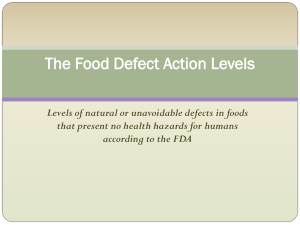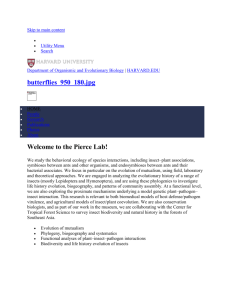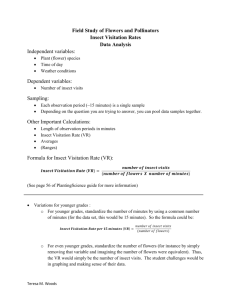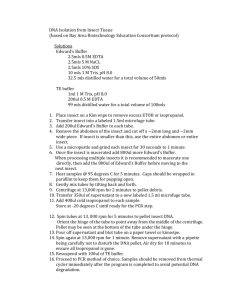Acknowledgements
advertisement
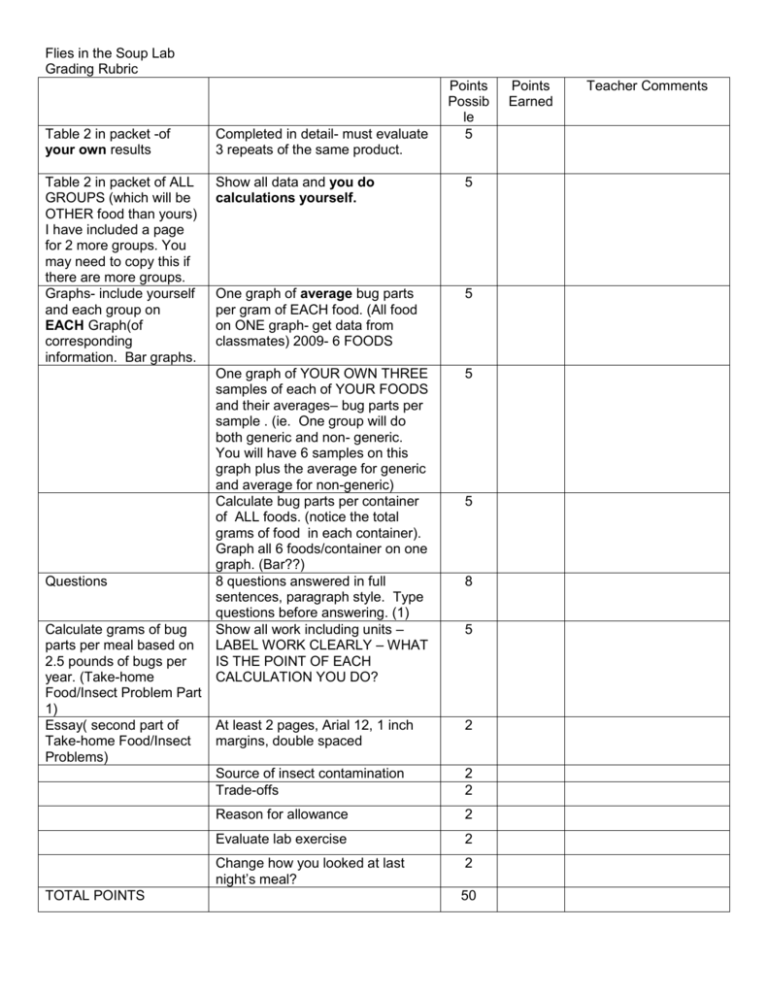
Flies in the Soup Lab Grading Rubric Points Possib le 5 Table 2 in packet -of your own results Completed in detail- must evaluate 3 repeats of the same product. Table 2 in packet of ALL GROUPS (which will be OTHER food than yours) I have included a page for 2 more groups. You may need to copy this if there are more groups. Graphs- include yourself and each group on EACH Graph(of corresponding information. Bar graphs. Show all data and you do calculations yourself. 5 One graph of average bug parts per gram of EACH food. (All food on ONE graph- get data from classmates) 2009- 6 FOODS 5 One graph of YOUR OWN THREE samples of each of YOUR FOODS and their averages– bug parts per sample . (ie. One group will do both generic and non- generic. You will have 6 samples on this graph plus the average for generic and average for non-generic) Calculate bug parts per container of ALL foods. (notice the total grams of food in each container). Graph all 6 foods/container on one graph. (Bar??) 8 questions answered in full sentences, paragraph style. Type questions before answering. (1) Show all work including units – LABEL WORK CLEARLY – WHAT IS THE POINT OF EACH CALCULATION YOU DO? 5 At least 2 pages, Arial 12, 1 inch margins, double spaced 2 Source of insect contamination Trade-offs 2 2 Reason for allowance 2 Evaluate lab exercise 2 Change how you looked at last night’s meal? 2 Questions Calculate grams of bug parts per meal based on 2.5 pounds of bugs per year. (Take-home Food/Insect Problem Part 1) Essay( second part of Take-home Food/Insect Problems) TOTAL POINTS 5 8 5 50 Points Earned Teacher Comments Biology Lab: Flies in the Soup and Maggots in the Marmalade: A Laboratory Exercise To Investigate Food Contamination by Insects (Mrs. Smith’s adaptation from sources listed at the end of the document) Background: Each year, the average American consumer unknowingly eats approximately 2.5 pounds of insect fragments, contaminants found in most fresh and processed foods (Olsen 1991). Because entirely eliminating insect contamination is impossible, the Food and Drug Administration has established guidelines for the number of insect “parts” that are allowable in retail foods (Wagner 1992). The guidelines are set forth in the "Food Defect Action Level List" in which foods are listed with amounts of contaminants, including insect parts which are allowable because of no known risk to human health (Code of Federal Regulations, 1998). The Food Defect Action Level lists many of our favorite foods. For example, chocolate has up to 60 insect parts allowed per 100 grams, macaroni and cheese boxed dinners have up to 225 parts allowable per 225 grams, and ground cinnamon has up to 400 insect fragments per 50 grams (http://vm.cfsan.fda.gov/~dms/dalbook.html)! The FDA sets the action levels (contamination levels at which food is rejected because contamination levels are unacceptable) because it is economically impractical to grow, harvest, and process raw products that are totally free of insect contamination. These “non-hazardous, naturally occurring” defects are often in the form of small pieces of insects that have been incorporated into the food during processing (Code of Federal Regulations 1998). The FDA guidelines (http://vm.cfsan.fda.gov/~dms/dalbook.html) present the maximum allowable contamination “based on natural or unavoidable defects in foods for human use that present no health hazard”. These guidelines are enforced through random inspections of food by FDA laboratories using sub-sampling techniques (Gentry, et al. 1991a, b). Sub-sampling is used to reduce the time, effort, and expense of examining a food product. Sub-sampling entails an assessment of a random portion of the whole product. It is thoroughly investigated and then the amount of contaminant in that sample is extrapolated to estimate the contaminant in the whole sample. For example, if a jar of grape jelly contains 400 grams and 2 insect parts are found in 1 gram, then the whole jar should contain about 800 insect parts. To ensure accuracy, multiple sub-samples (at least 4) are taken, and the amounts of contamination found in each are multiplied by the total amount of product to obtain an average contamination per amount of product. Table 1 shows excerpts from the FDA food defect action level report showing the product, source of insect contamination and its significance to the consumer (http://vm.cfsan.fda.gov/~dms/dalbook.html). In addition to these foods, many other foods contain thresholds for insect contamination. Other products do not have defect levels because of low levels of contamination or because contamination poses no threat. The FDA list provides the following information: PRODUCTS WITHOUT DEFECT LEVELS “If there is no defect action level for a product, or when findings show levels or types of defects that do not appear to fit the action level criteria, FDA evaluates the samples and decides on a case-by-case basis. In this procedure, FDA's technical and regulatory experts in filth and extraneous materials use a variety of criteria, often in combination, in determining the significance and regulatory impact of the findings. The criteria considered are based on the reported findings (e.g., lengths of hairs, sizes of insect fragments, distribution of filth in the sample, and combinations of filth types found). Moreover, FDA interprets the findings considering available scientific information (e.g., ecology of animal species represented) and the knowledge of how a product is grown, harvested, and processed.” Table 1. SELECTED FOODS AND ACCEPTABLE CONTAMINATION LEVELS APPLE BUTTER Insects Average of 5 or more whole or equivalent insects (not counting mites, aphids, thrips, or scale insects) per 100 grams of apple butter DEFECT SOURCE: Whole or equivalent insects - preharvest, and/or post harvest and/or processing insect infestation SIGNIFICANCE: Aesthetic APRICOTS, CANNED Insect filth Average of 2% or more by count has been damaged or infected by insects DEFECT SOURCE: Pre-harvest insect infestation SIGNIFICANCE: Aesthetic CHOCOLATE AND Insect filth Average is 60 or more insect CHOCOLATE LIQUOR fragments per 100 grams when 6 100-gram subsamples are examined OR Any 1 subsample contains 90 or more insect fragments DEFECT SOURCE: Insect fragments - post harvest and/or processing insect infestation. SIGNIFICANCE: Aesthetic MACARONI AND Insect filth Average of 225 insect NOODLE PRODUCTS fragments or more per 225 grams in 6 or more subsamples DEFECT SOURCE: Insect fragments - preharvest and/or post harvest and/or processing infestation. SIGNIFICANCE: Aesthetic OREGANO, GROUND Insect filth Average of 1250 or more insect fragments per 10 grams DEFECT SOURCE: Insect fragments - preharvest and/or post harvest and/or processing insect infestation. SIGNIFICANCE: Aesthetic TOMATO PASTE, PIZZA Drosophila fly Average of 30 or more fly AND OTHER SAUCES eggs per 100 grams OR 15 or more fly eggs and 1 or more maggots per 100 grams OR 2 or more maggots per 100 grams in a minimum of 12 subsamples DEFECT SOURCE: Pre-harvest and/or post harvest and/or processing insect infestation SIGNIFICANCE: Aesthetic WHEAT FLOUR Insect filth Average of 75 or more insect fragments per 50 grams DEFECT SOURCE: Insect fragments - pre-harvest and/or post harvest and/or processing insect infestation. SIGNIFICANCE: Aesthetic Preventing the defects from insect contamination is not an easy task. In fact pesticides are most often used in a field to either prevent loss of yield (mass per acre) to insect pests or to prevent loss of aesthetic value of a crop. Often the threshold to prevent aesthetic loss is very low because in general consumers avoid agricultural products with any form of damage (holes in the apple, bruised fruit, beans with feeding damage, etc.). During processing, few pesticides can be applied for obvious reasons. The stance of the FDA is evident in the following statement: USE OF CHEMICAL SUBSTANCES TO ELIMINATE DEFECT LEVELS “It is FDA's position that pesticides are not the alternative to preventing food defects. The use of chemical substances to control insects, rodents and other natural contaminants has little, if any impact on natural and unavoidable defects in foods. The primary use of pesticides in the field is to protect food plants from being ravaged by destructive plant pests (leaf feeders, stem borers, etc.). A secondary use of pesticides is for cosmetic purposes--to prevent some food products from becoming so severely damaged by pests that it becomes unfit to eat.” Materials and Methods Materials: Cheesecloth 10 ml Pipettes Tweezers, dissecting needle Funnel 50 ml Graduated Cylinder Petri Dishes Electronic Scale (optional) Stereoscope Light Microscope Slides and cover slips Distilled water Tablespoon (may be needed to break up jelly) Suggested food list: Apple butter Jelly (any flavor) Apricot preserves Paprika Ketchup Tomato Sauce Methods Jelly and Apricot Preserves Students, who extract contamination from jelly or apricot preserves use cheesecloth, a funnel, a graduated cylinder, tap or distilled water, a pipette, a petri dish, tweezers, a tablespoon, slides and cover slips, stereoscope and microscope. After the materials are collected, the students set up a simple apparatus to filter the jelly through the cheesecloth. A piece of cheesecloth (approximately 6 inch by 12 inch) is cut and folded over once resulting in a 6 inch by 6 inch piece. This piece of cheesecloth is then placed inside the funnel as a lining. The funnel is placed in a 50 ml graduated cylinder so the amount of filtrate can be measured. After this apparatus is set up, the students measure out about a tablespoon or 3-5 grams of jelly/preserves. This sample of jelly/preserves can then be placed in the middle of the cheesecloth in the funnel. Water is poured over the jelly while breaking up the jelly using a tablespoon, and the filtrate is collected in the graduated cylinder. This procedure helps to break up the jelly/preserves so the insect fragments can be dislodged from the jelly. After filtering about 40 ml of water the student can discard the jelly/preserves and cheesecloth, saving the water in the graduated cylinder. From the graduated cylinder, the students extract 5 ml samples from the bottom (the exoskeleton of insects sinks) by pipette to a petri dish. The petri dish is then placed under a stereoscope and the student can pick out possible insect fragments. Anything that is extracted from the petri dish should be placed on a slide, covered with a cover slip, and analyzed using a compound microscope. Apple Butter Students can use the same technique as with jelly to extract insect fragments from apple butter. Alternatively, students can take a much smaller sample and dilute it with water. To do this procedure, students measure out one gram of apple butter in a Petri dish and add about five milliliters of distilled water. Students stir the sample with a toothpick until water in dispersed throughout. Students can then pick out suspect insect fragments and mount them on slides. These slides are then examined using a light microscope. Ketchup/Tomato Sauce Students examining ketchup/tomato sauce will use the alternative technique outlined in the apple butter methods section. Students will measure out about 1 teaspoon or 0.5 grams of ketchup/tomato sauce, place it in a Petri dish, and dilute it with about 5 ml of water. The students can look through the sample under the stereoscope and place any suspect pieces onto slides to be looked at under the compound microscope. Paprika/Spices Paprika and other spices are harder to examine because contamination is difficult to separate from the dry powder. Students should place approximately one gram of the sample in a petri dish and begin by looking at it through a stereoscope. They should use a dissecting needle to separate the sample. Anything that looks suspect should be placed on a slide and looked at under a compound microscope. Macaroni and Cheese The macaroni noodles can be placed directly onto a petri dish to be analyzed under a stereoscope. Pasta noodles often have rodent hair that can be seen directly using a stereoscope. The powdered cheese should be investigated for contamination by examining it as with the spices under a dissecting scope. Tips: Distinguish plant cells from insect parts by detecting cell walls. Figure 3 shows the contrast between an insect part and a plant cell wall from samples obtained in ketchup. Figure 2. A mite, found in grape jelly. Figure 3. Insect contamination (left) and plant part (right). Students can distinguish plant from animal cells based on the presence of cell walls. Results Students should fill in table 2 with the results of their investigation. They should report how many insect fragments or pieces of contamination they find in each sample. Table 2. Insect contamination of foods examined. YOUR FOOD Product TRIALS Sample Mass or volume # Insect contamination Notes 1. 2. 3. TOTALS AVERAGE IN SAMPLES Average parts per GRAM (show your work) Extrapolate how many parts in the entire container of your sample (Show ALL of your work) This table is the data for _______________________ (names in group) Table 2. Insect contamination of foods examined. Product trials Sample Mass or volume # Insect contamination Notes 1. 2. 3. TOTALS AVERAGE IN SAMPLES Average parts per GRAM (show your work) Extrapolate how many parts in the entire container of your sample (Show ALL of your work) This table is the data for _______________________ (names in group) Table 2. Insect contamination of foods examined. Product TRAILS Sample Mass or volume # Insect contamination Notes 1. 2. 3. TOTALS AVERAGE IN SAMPLES Average parts per GRAM (show your work) Extrapolate how many parts in the entire container of your sample (Show ALL of your work) Analysis 1. Create a computer generated bar chart comparing food types. Use the results from each classmate’s food. Questions to answer: (Answer on a separate sheet of paper) 1. Based on you observations of the sub-sample, would any of these products be rejected under the FDA allowable contamination levels? 2. Was there any difference in the amount of insect contamination between name brand and generic-brand foods? If so, describe the difference. 3. What would you do to improve this investigation of contamination? 4. Are there any products that you will not eat anymore? 5. Why are there allowable insect contamination levels in human foods? 6. What feature allowed you to distinguish between animal and plant contamination of food? 7. Do you think you found all of the insect parts in the food that you sampled? 8. What other methods might you try to better quantify insect contamination? Take-home Food/ Insect Problem. First part of the assignment: Calculate how many grams of insect parts you need to eat on average with every meal to eat 2.5 pounds a year. Show all work and all assumptions. So, for example, assume that you eat x pounds of food for breakfast, x for lunch and x for dinner, how many pounds is that for the day? Assume that this is a normal, not leap year. Some useful conversions: 1 kilogram = 2.2046 pounds; 1 ounce = 28.35 grams; 16 ounces = 1 pound. Second part: So, why do you eat so many insect parts at all? Please write an essay discussing each of the following questions: What is the source(s) of insect contamination in your food? What would be the trade-offs to have insect-free food? What is the reason(s) the Food and Drug Administration allows a specific number of insect and/or insect parts in many of the foods you eat? What is your evaluation of this laboratory exercise in which you examined food for insect parts? Did the results change the way you looked at last night's meal? Explain. (Use my standard format: 1 inch margins, Arial 12 font, double spaced- Prabably need at least 2 full pages to accomplish this well!) Facts that will help. Sources are listed so that you can look up more details. You may also use sources that you find on the net. 1. In the late 1980s chlordane contamination (a pesticide used to control termites) was estimated to affect inhabitants of up to 75% of U.S. homes. In 1999 Lindane was banned on apples because it was potentially carcinogenic. Most recently (2000), the chemical chlorpyrifos, an organophosphate used to control mosquitoes, cockroaches, fruit and vegetable crop pests, and lawn pests, was banned because of potential neurological damage to children. The ban has been highly controversial with several scientists arguing that exposure to insects capable of transmitting pathogens is more dangerous than exposure to the pesticide. For more information on chlorpyrifos, consult http://www.soton.ac.uk/~jrc3/chudler/pest.html. 2. Also, in a paper by Peterson and Shurdut (1999): This presents a relatively non-technical (suitable for non-majors) paper on health risks associated with cockroaches versus those associated with pesticide. Your discussion can focus on such questions as the type of insect contamination and its consequences (i.e. eating a flour beetle is a lot less risky than eating a cockroach) and the risk from pesticide exposure (a relatively large contingent of organic farmers present information on the World Wide Web). TO TAKE THIS LAB FURTHER: Because insects naturally colonize food products and their populations grow through time, an ecological demonstration to expand our laboratory exercise could be created. Food products such as flour, cake mix, cereals, etc. could be brought in to the laboratory, opened, and then examined periodically over the course of the semester. Flour and grain products that have been stored for a long period of time and are open to the environment usually develop colonies of various small insects including flour beetles and flour moths. A website containing information and pictures of common household pests of opened products has been posted by Townsend (2001). Acknowledgements This project was developed as part of the undergraduate independent research requirement in the Department of Biology. We thank the department for its support and especially Julie Shaffer, Charlie Bicak, Leon Higley, and two anonymous reviewers for useful comments on earlier versions of this manuscript. Literature Cited Code of Federal Regulations, 1998. U.S. General Services Administration, National Archives and Records Service, Office of the Federal Register. Washington D.C. Gentry, J. W., and K. L. Harris, and J. W. Gentry, Jr. 1991a. Microanalytical Entomology for Food Sanitation Control. Volume 1. Melbourne, Florida. Gentry, J. W., and K. L. Harris, and James W. Gentry, Jr. 1991b. Microanalytical Entomology for Food Sanitation Control. Volume II. Melbourne, Florida. Olsen, A. R. July-August 1991. FDA teamwork uncovers insect infestation. Volume 25. Number 6. pp. 43-46. FDA Consumer. Peterson, R.K.D. and B.A. Shurdut. 1999. Human heath risks from cockroaches and cockroach management: a risk analysis approach. American Entomologist 45: 142-148. Wagner, B. 1992. FDA keeps antennae out for insect fragments. FDA Consumer. Volume 26, Number 9. pp. 19-23. http://vm.cfsan.fda.gov/~dms/dalbook.html. FDA Food Defect Action Level. http://vm.cfsan.fda.gov/~lrd/fdaact.html. Action levels for poisonous or deleterious substances in human food and animal feed. Additional tables. This table is the data for _______________________ (names in group) Table 2. Insect contamination of foods examined. Product TRIALS Sample Mass or volume # Insect contamination Notes 1. 2. 3. TOTALS AVERAGE IN SAMPLES Average parts per GRAM (show your work) Extrapolate how many parts in the entire container of your sample (Show ALL of your work) This table is the data for _______________________ (names in group) Table 2. Insect contamination of foods examined. Product TRIALS Sample Mass or volume # Insect contamination Notes 1. 2. 3. TOTALS AVERAGE IN SAMPLES Average parts per GRAM (show your work) Extrapolate how many parts in the entire container of your sample (Show ALL of your work)

